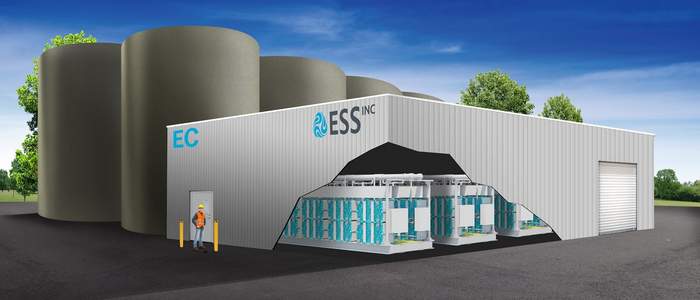Long-duration iron-based flow battery company ESS Inc., is debuting a new concept — the Energy Center — to provide flexible utility-scale energy storage systems to meet the needs of front-side-of-the-meter use cases and larger commercial and industrial facilities. In contrast to the company’s Energy Warehouse, a standalone 75 kW/500 kWh containerized system, the Energy Center can be tailored and scaled to accommodate specific projects and enable the stacking of a range of storage applications.
The systems can be configured in different power capacities, starting at 3 MW, and energy durations ranging from 6 to 16 hours, to support large-scale renewable energy projects, provide transmission- and distribution-level services, and for utility peaker plant replacement applications. Underscoring their sustainable value and low operating cost, Energy Centers have a projected operating life of approximately 25 years without performance degradation.
“As we are seeing market requirements for utility-scale energy storage moving from the traditional 2-to-4-hour lithium-ion-based capability to longer 8-to-12-hour durations that emphasize flexibility and long life, it is clear that proven and practical flow batteries offer key design and cost advantages over lithium,” stated Mark Burton, Senior Engineer for Energy Storage at Enertis Solar. “We have been working closely with ESS on optimizing the overall design of the Energy Center solution to meet the unique site design and balance of plant requirements for these large, long-duration battery systems.”
According to Guidehouse, annual flow battery project deployment revenue on a global basis is projected to grow more than 25-fold, from $134.7 million in 2019 to $3.5 billion by 2028. In California alone, the state will need to deploy between 45-55 GW of long-duration energy storage to meet its goal of eliminating GHG from electricity by 2045.
Battery info: The Energy Center utilizes an environmentally benign and sustainable flow battery chemistry composed of earth-abundant iron, salt, and water, and containing no hazardous chemicals or rare-earth metals. The iron flow battery presents no fire, chemical, or explosive risk, eliminating the need for fire suppression, secondary containment, and hazmat precautions, resulting in the greenest, most sustainable, and easiest-to-permit storage technology available.
In an independent assessment conducted at the University of California-Irvine, scientists evaluated the environmental impact of three different flow battery chemistries, to which was added supplementary information analyzing four different lithium-ion designs. Researchers assessed production processes and end-of-life stages and compared results, measuring global warming potential, ozone depletion potential, acidification potential, freshwater usage and other environmental criteria. Among flow batteries, ESS Inc.’s all-iron technology presented the lowest overall environmental impact compared to batteries using vanadium and zinc. They’re also significantly less harmful to the environment than lithium-ion batteries, thanks to earth-abundant materials, far longer operating life, and ease of end-of-life material recycling.
In conjunction with the company’s pioneering energy storage solutions, ESS Inc. offers the only utility-scale battery platform that includes a comprehensive 10-year insurance policy covering the product performance. Backed by Munich RE, the world leader in the development of new insurance solutions for climate-friendly technologies, this policy provides customers with the assurance of a long-term performance guarantee.
— Solar Builder magazine


Leave a Reply
You must be logged in to post a comment.